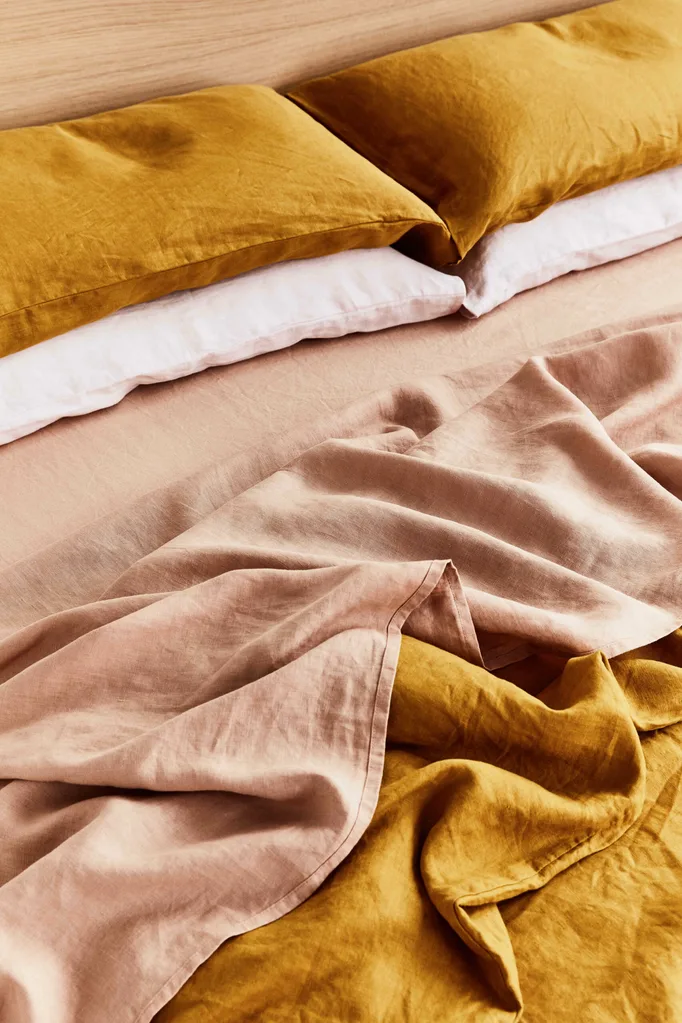Each of us spends a third of our lifetime snoozing, wrapped up in our bedding for hours on end, so it only makes sense that our nightly wrappings need to be changed every so often.
And while, yes, changing our bedsheets—and that impossible fitted sheet—is a task that’s easy to actively avoid, but perhaps our mothers were right in their monotonous hounding and questioning over our bedding hygiene.
Aside from a rendezvous in the washing machine, another real question that plagues the adult mind is: how often should we be replacing our bedding? Because after all, waiting until holes appear is far too long.
Thankfully, marie claire spoke to Genevieve Rosen-Biller, co-founder of Bed Threads, to nab the low-down on when one should wash and replace their bedroom essentials, minus panic-calling Mum.

Despite sitting on top of bed sheets, one would be surprised as to how much bacteria a duvet can accumulate, which is why Rosen-Biller suggests keeping an eye on it.
“You should machine wash or dry clean your duvet at least twice per year, according to the care labelm” she advises. “If you sleep with your duvet closer to your body, i.e. without a flat sheet between, consider washing it every few months.”
As for how often one should replace a duvet entirely, turns out, it’s important to do so a little sooner than expected.
“Your duvet has the longest lifespan of all your bedding,” she explained. “And only needs to be replaced every five years, or sooner if it starts to look a little lumpy.”
When it comes to bed sheets themselves, it’s common knowledge that a semi-frequent wash is expected, especially to Rosen-Biller.
“Ideally you should be washing your sheets once a week to detox them of the fungi, bacteria, skin cells and sweat that can accumulate,” she advises.
“Pop them in the wash on a gentle, cold or warm water cycle with a mild detergent then air dry them on the line in the sun to kill any germs.”
Of course, a vigorous washing routine is enough to keep the bacteria at bay, there will come a time where a complete refresh is mandatory.
The Bed Threads co-founder explains that one “should replace your sheets every few years, depending on the fabric they are made from and how often you wash them,”
“100% French flax linen will last longer than other materials thanks to the durability. In fact, compared to other manchester, linen thread is twice as durable,” she explained.
“If you have had your sheets for longer than a few years though, there could be bacteria and microorganisms living in the threads of the fabric!”

If that didn’t give you the ick factor, then it’s time to consider where one lays their head. Rosen-Biller suggests that pillow cases should be washed “every two to three days”, in order to help “avoid the build up of cosmetic products, dead skin cells, oils and dirt from your skin and hair and surrounding environment, which can cause breakouts and irritation.”
“Pillowcases should be replaced every couple of years,” Rosen-Biller continued. “Due to washing them more frequently than your sheets.”
And while, yes, washing the case is straight foward, but what about the pillow itself. While it’s normal to ponder on how washing a pillow would even work—or better yet, how it would dry inside-and-out—Rosen-Biller suggests that a simple tumble dry will solve the problem.
“Pillows should be washed every 6 months to keep bacteria at bay and also help to prolong their life,” she advises.
“You can wash down and fibre filled pillows on a warm, gentle cycle with detergent then tumble dry on a low heat setting, stopping the cycle to fluff them back up again every now and then.”
But alas, it’s vital that the pillow itself is replaced, not just when it reaches the same height as a slim pancake, but when it’s absorbed too much bacteria.
“Your pillows absorb body oil, dead skin cells and hair which can attract dust mites and trigger allergies,” Rosen-Biller explained. “So it’s important to replace them every 1 to 2 years.”

And last but not least, the biggest—and most cumbersome—bedding item to spring clean: the mattress.
“It’s important to clean your mattress at least twice a year,” she explains.
Rather than attempting to fold a mattress into the front loader, Rosen-Biller suggests that simple spot cleaning can be more than enough, along with a sprinkle of baking soda and a vacuum cleaner to get the mattress feeling as good as new.
“Vacuum with an upholstery attachment, spot clean with a stain remover, sprinkle the entire mattress with baking soda and leave for a few hours before vacuuming again. In between, protect it with a mattress protector and let it air out every three to six months.”
Thankfully, the boudoir’s most expensive item doesn’t requirement frequent replacing, in fact, it can be stretched as far as a decade before it’s time to bid it adieu.
“It’s recommended to buy a new mattress about every eight years, 10 at a stretch,” Rosen-Biller advises.
“Any longer than this may mean your old mattress is no longer providing the support you need for a good night’s sleep and is accumulating dust mites and allergens.”
Need to replace some bedroom attire? Head to Bed Threads to give your boudoir a likely long-overdue freshen up.










